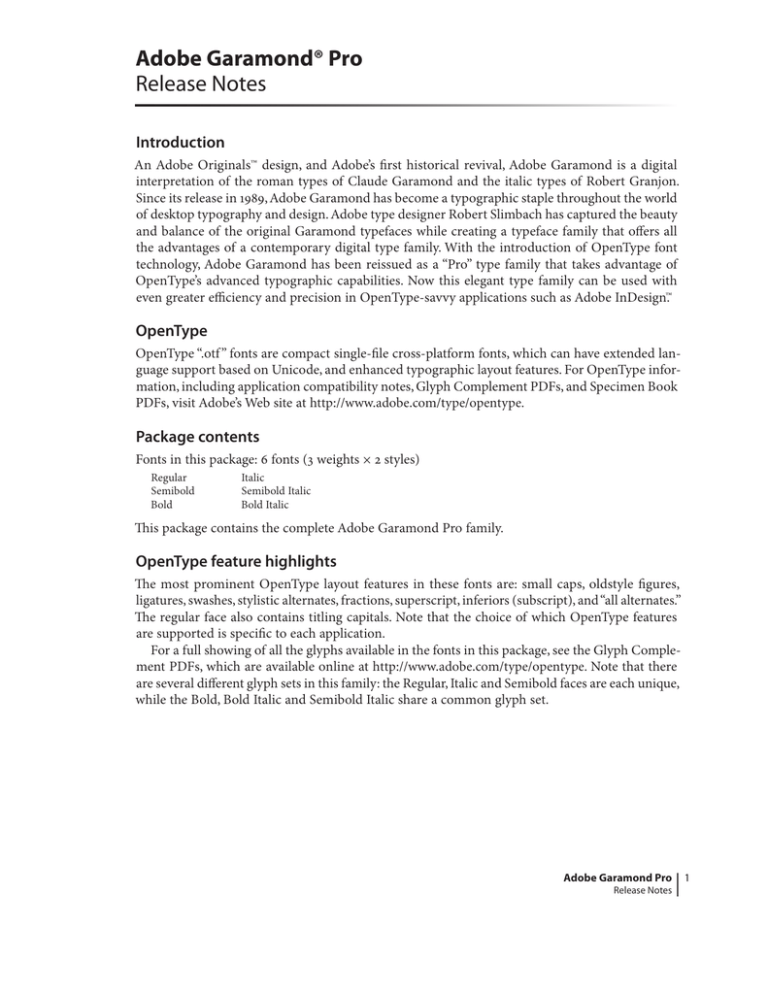
Adobe Garamond® Pro
Release Notes
Introduction
An Adobe Originals™ design, and Adobe’s first historical revival, Adobe Garamond is a digital
interpretation of the roman types of Claude Garamond and the italic types of Robert Granjon.
Since its release in , Adobe Garamond has become a typographic staple throughout the world
of desktop typography and design. Adobe type designer Robert Slimbach has captured the beauty
and balance of the original Garamond typefaces while creating a typeface family that offers all
the advantages of a contemporary digital type family. With the introduction of OpenType font
technology, Adobe Garamond has been reissued as a “Pro” type family that takes advantage of
OpenType’s advanced typographic capabilities. Now this elegant type family can be used with
even greater efficiency and precision in OpenType-savvy applications such as Adobe InDesign.™
OpenType
OpenType “.otf ” fonts are compact single-file cross-platform fonts, which can have extended language support based on Unicode, and enhanced typographic layout features. For OpenType information, including application compatibility notes, Glyph Complement PDFs, and Specimen Book
PDFs, visit Adobe’s Web site at http://www.adobe.com/type/opentype.
Package contents
Fonts in this package: fonts ( weights × styles)
Regular
Semibold
Bold
Italic
Semibold Italic
Bold Italic
is package contains the complete Adobe Garamond Pro family.
OpenType feature highlights
e most prominent OpenType layout features in these fonts are: small caps, oldstyle figures,
ligatures, swashes, stylistic alternates, fractions, superscript, inferiors (subscript), and “all alternates.”
e regular face also contains titling capitals. Note that the choice of which OpenType features
are supported is specific to each application.
For a full showing of all the glyphs available in the fonts in this package, see the Glyph Complement PDFs, which are available online at http://www.adobe.com/type/opentype. Note that there
are several different glyph sets in this family: the Regular, Italic and Semibold faces are each unique,
while the Bold, Bold Italic and Semibold Italic share a common glyph set.
Adobe Garamond Pro
Release Notes
1
Style links & font menus
e weight link in this family is Regular to Semibold; Regular does not link to the “Bold” weight.
In most non-OpenType-savvy Windows applications, instead of every font appearing on the
menu, italic styles and bold weight variants are only accessible by use of the italic and bold style
buttons. With Adobe Garamond Pro, you could have all six fonts of the family installed. However,
in a typical Windows font menu you would see only the Regular and the Bold; the italics are
accessed via the italic style button, and the Semibold by selecting the regular and using the bold
style button. e true “Bold” font accessed by selecting it directly from the menu is bolder than
the Semibold (which is accessed by using the Regular font with the Bold style link).
Note that the Bold and Bold Italic fonts do not have a more-bold style available. Selecting the
bold style button when using these fonts in a typical Windows or Macintosh application will either
have no effect, or result in “faked” further bolding, which will usually produce inferior screen and
print results.
On the Mac OS, although each font appears as a separate entry on the font menu, users may also
select fonts by means of style links. Selecting the upright “base weight” and then using the style
links as appropriate enhances cross-platform document compatibility with many applications,
such as Microso Word and Adobe PageMaker®, although it is unnecessary with more sophisticated Adobe applications such as recent versions of Illustrator®, Photoshop® or InDesign®. One
should not, however, select a style-linked “bold” (in this case, the Semibold) from the menu, and
then use the bold styling button in addition; doing so will result in the “fake bold” mentioned
above. ( e same is also true for italics.)
Language coverage
ISO-Adobe and Adobe CE (Central European)
Windows code pages supported
Latin 1: WinANSI (code page )
Latin 2: Eastern Europe ()
Turkish ()
Windows Baltic ()
Mac OS language support
On Mac OS 8–9, with applications using OS-level language support, only the MacRoman encoding
is supported. Support for the following additional Mac language groups exists in the font, and
may be available in some Adobe applications, or in future Mac OS versions:
Central European (includes Czech, Hungarian, Slovak, Polish, Latvian, Lithuanian, Slovenian
and Estonian)
Romanian
Croatian
Icelandic & Faroese
Turkish
bc
© 2000 Adobe Systems Incorporated. All rights reserved. Adobe, the Adobe logo, Adobe
Originals, InDesign, Illustrator, PageMaker, Photoshop and Adobe Garamond are either
registered trademarks or trademarks of Adobe Systems Incorporated in the United
States and/or other countries. Microsoft, OpenType, Windows and Word are either registered trademarks or trademarks of Microsoft Corporation in the United States and/or
other countries. Macintosh, Mac and Mac OS are trademarks of Apple Computer, Inc.,
registered in the United States and other countries. (2000/07/07)
Adobe Garamond Pro
Release Notes
2
